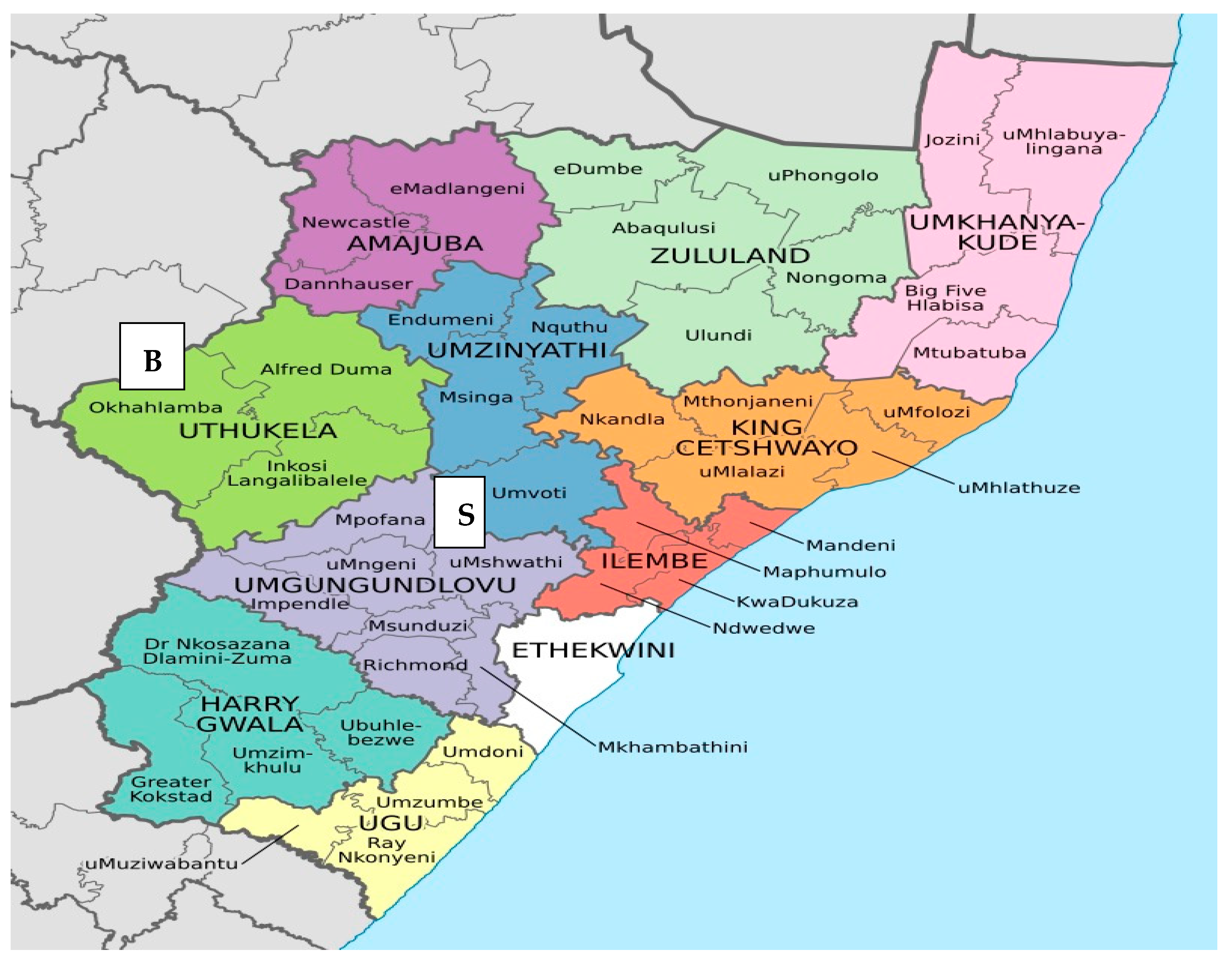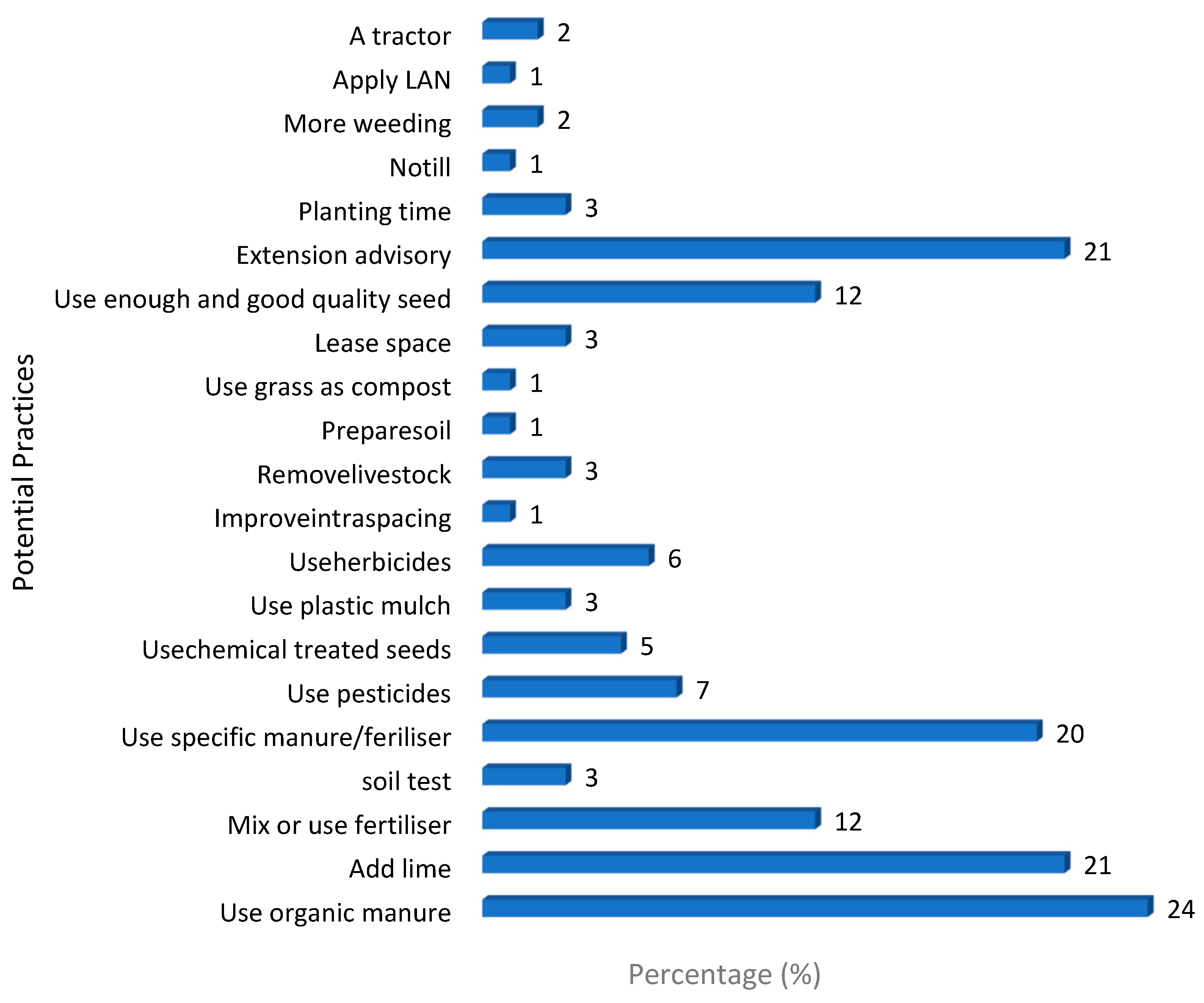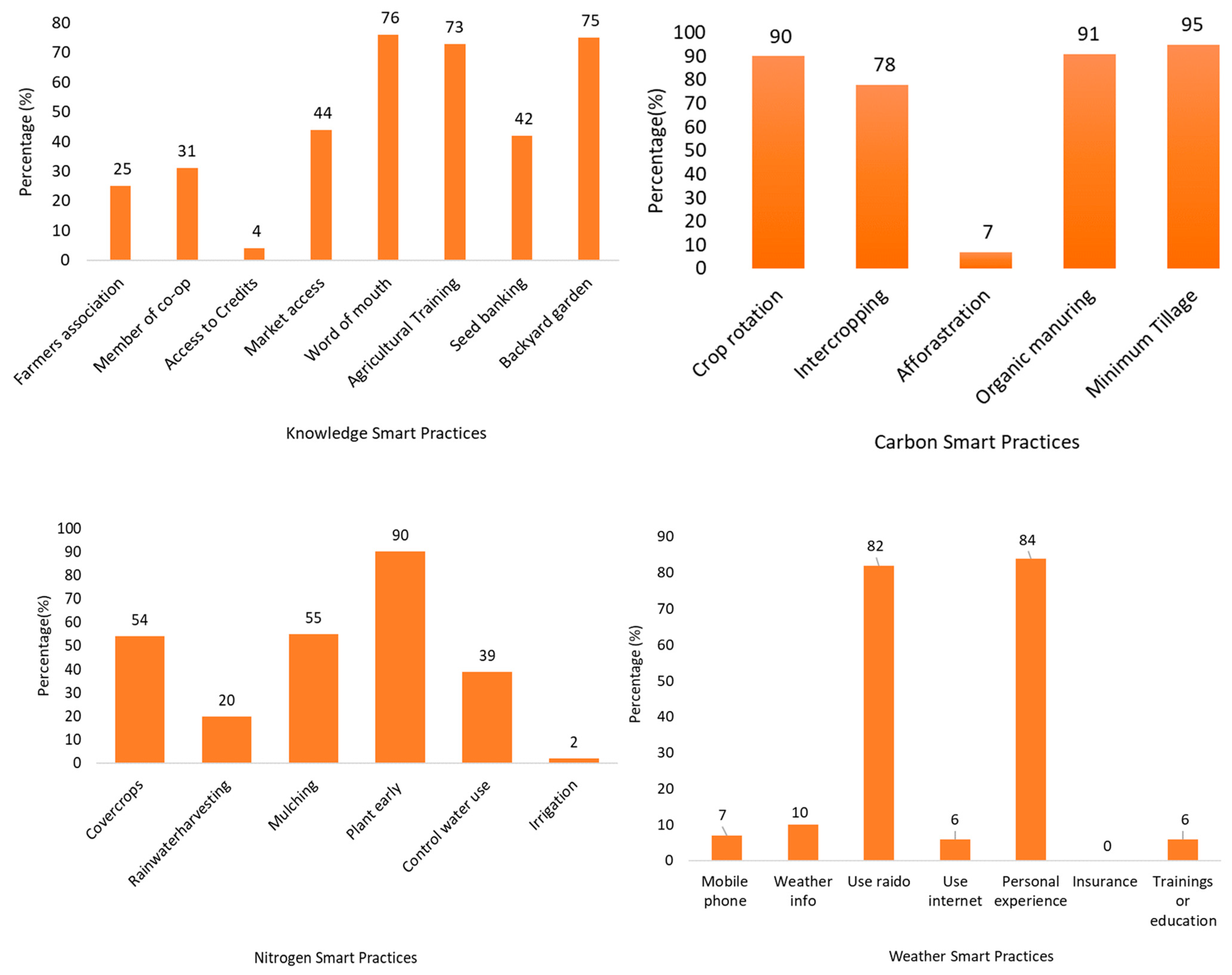The Determinants of Adoption and Intensity of Climate-Smart Agricultural Practices among Smallholder Maize Farmers
Abstract
1. Introduction
2. Methodology
2.1. Description of the Study Area
2.2. Data Collection Method
2.3. Conceptual Framework
2.3.1. The Determinants of CSA Adoption by Smallholder Maize Farmers
2.3.2. The Intensity of CSA Use among Smallholder Maize Farmers
3. Description of Variables and Statistics
4. Results
4.1. Descriptive Analysis of the Results
4.1.1. Demographic Characteristics of Smallholder Farmers in the Study Area
4.1.2. Climate Change Impact (Natural Hazards) Experienced by Farmers in Their Maize Production in 2019–2020
4.1.3. Short-Term CSA Practices Adopted by Smallholder Maize Farmers to Cope with Natural Hazards in the 2019–2020 Season
4.1.4. Potential Practices Which Farmers Can Put in Place to Adapt to Climate Change
4.1.5. The Adaptation Strategies Employed by Smallholder Farmers over Ten Years of Maize Production
4.1.6. Determinants of Adoption of Climate Change Adaptation Strategies among Maize Farmers Probit Model
4.1.7. Determinants of the Intensity of CSA Adoption
5. Discussion
6. Conclusions and Policy Recommendations
Author Contributions
Funding
Institutional Review Board Statement
Informed Consent Statement
Conflicts of Interest
References
- Pienaar, L.; Traub, L. Understanding the smallholder farmer in South Africa: Towards a sustainable livelihoods classification. In Proceedings of the International Association of Agricultural Economists (IAAE) 2015 Conference, Milan, Italy, 9–14 August 2015. [Google Scholar]
- Chamberlin, J. It’s Small World After All: Defining Smallholder Agriculture in Ghana; International Food Policy Research Institute: Washington, DC, USA, 2008; Volume 823. [Google Scholar]
- Food and Agriculture Organization (FAO). The Economic Lives of Smallholder Farmers. 2015. Available online: http//www.fao.org (accessed on 29 June 2022).
- Kom, Z.; Nethengwe, N.S.; Mpandeli, N.S.; Chikoore, H. Determinants of small-scale farmers’ choice and adaptive strategies in response to climatic shocks in Vhembe District, South Africa. GeoJournal 2020, 87, 677–700. [Google Scholar] [CrossRef]
- Adeagbo, O.A.; Ojo, T.O.; Adetoro, A.A. Understanding the determinants of climate change adaptation strategies among smallholder maize farmers in South-west, Nigeria. Heliyon 2021, 7, 06231. [Google Scholar] [CrossRef] [PubMed]
- Jimoh, L.; Akintunde, O.; Kehinde, A.; Agboola, T.; Alabi, A. Structure, Conduct and Performance of Maize Marketing in Irewole Local Government Area, Osun State. Niger. J. Basic Appl. Sci. 2022, 29, 59–66. [Google Scholar] [CrossRef]
- Diaz-Ambrona, C.G.; Gigena, R.; Mendoza, C.O. Climate change impacts on maize and dry bean yields of smallholder farmers in Honduras. Iberoam. J. Dev. Stud. 2013, 2, 4–22. [Google Scholar] [CrossRef]
- Harvey, C.A.; Saborio-Rodríguez, M.; Martinez-Rodríguez, M.R.; Viguera, B.; Chain-Guadarrama, A.; Vignola, R.; Alpizar, F. Climate change impacts and adaptation among smallholder farmers in Central America. Agric. Food Secur. 2018, 7, 57. [Google Scholar] [CrossRef]
- Food and Agriculture Organization (FAO). Climate Smart Agriculture: Managing ecosystem for Sustainable Livelihoods. Undated. Available online: www.fao.org/climatechange/climatesmart (accessed on 30 June 2022).
- Wekesa, B.M.; Ayuya, O.I.; Lagat, J.K. Effect of climate-smart agricultural practices on household food security in smallholder production systems: Micro-level evidence from Kenya. Agric. Food Secur. 2018, 7, 1–14. [Google Scholar] [CrossRef]
- Antwi-Agyei, P.; Abalo, E.M.; Dougill, A.J.; Baffour-Ata, F. Motivations, enablers and barriers to the adoption of climate-smart agricultural practices by smallholder farmers: Evidence from the transitional and savannah agroecological zones of Ghana. Reg. Sustain. 2021, 2, 375–386. [Google Scholar] [CrossRef]
- McCarthy, N.; Lipper, L.; Branca, G. Climate-smart agriculture: Smallholder adoption and implications for climate change adaptation and mitigation. Mitig. Clim. Chang. Agric. Work. Pap. 2011, 3, 1–37. [Google Scholar]
- Zougmoré, R.; Partey, S.; Ouédraogo, M.; Omitoyin, B.; Thomas, T.; Ayantunde, A.; Ericksen, P.; Said, M.; Jalloh, A. Toward climate-smart agriculture in West Africa: A review of climate change impacts, adaptation strategies and policy developments for the livestock, fishery and crop production sectors. Agric. Food Secur. 2016, 5, 26. [Google Scholar] [CrossRef]
- Ogunyiola, A.; Gardezi, M.; Vij, S. Smallholder farmers’ engagement with climate smart agriculture in Africa: Role of local knowledge and upscaling. Clim. Policy 2022, 22, 411–426. [Google Scholar] [CrossRef]
- Scherr, S.J.; Shames, S.; Friedman, R. From climate-smart agriculture to climate-smart landscapes. Agric. Food Secur. 2012, 1, 12. [Google Scholar] [CrossRef]
- Kolawole, O.D.; Wolski, P.; Ngwenya, B.; Mmopelwa, G. Ethno-meteorology and scientific weather forecasting: Small farmers and scientists’ perspectives on climate variability in the Okavango Delta, Botswana. Clim. Risk Manag. 2014, 4-5, 43–58. [Google Scholar] [CrossRef]
- Westermann, O.; Förch, W.; Thornton, P.; Körner, J.; Cramer, L.; Campbell, B. Scaling up agricultural interventions: Case studies of climate-smart agriculture. Agric. Syst. 2018, 165, 283–293. [Google Scholar] [CrossRef]
- Mazibuko, N.L. Selection and Implementation of Climate Smart Agricultural Technologies: Performance and Willingness for Adoption. Ph.D. Thesis, College of Agriculture, Engineering and Science, Pietermaritzburg, South Africa, 2018. [Google Scholar]
- Abegunde, V.O.; Sibanda, M.; Obi, A. Determinants of the adoption of climate-smart agricultural practices by small-scale farming households in King Cetshwayo District Municipality, South Africa. Sustainability 2019, 12, 195. [Google Scholar] [CrossRef]
- Statistics South Africa (Stats SA). Category Archives: Food Security and Hunger. 2021. Available online: http://www.statsa.gorv.za (accessed on 20 August 2022).
- Board, C.M.A. National Security and the Accelerating Risks of Climate Change; CNA Corp.: Arlington County, VA, USA, 2014. [Google Scholar]
- Mpanza, T.P. An evaluation of the perceived benefits and constraints of community gardens established by the KwaZulu-Natal Department of Agriculture and Environmental Affairs. Ph.D. Thesis, College of Agriculture, Engineering and Science, Pietermaritzburg, South Africa, 2008. [Google Scholar]
- Asrat, P.; Simane, B. Farmers’ perception of climate change and adaptation strategies in the Dabus watershed, North-West Ethiopia. Ecol. Processes 2018, 7, 1–13. [Google Scholar] [CrossRef]
- Wooldridge, J.M. Inverse probability weighted M-estimators for sample selection, attrition, and stratification. Port. Econ. J. 2002, 1, 117–139. [Google Scholar] [CrossRef]
- De Luca, G.; Perotti, V. Estimation of ordered response models with sample selection. Stata J. 2011, 11, 213–239. [Google Scholar] [CrossRef]
- Serote, B.; Mokgehle, S.; Du Plooy, C.; Mpandeli, S.; Nhamo, L.; Senyolo, G. Factors Influencing the Adoption of Climate-Smart Irrigation Technologies for Sustainable Crop Productivity by Smallholder Farmers in Arid Areas of South Africa. Agriculture 2021, 11, 1222. [Google Scholar] [CrossRef]
- Mutenje, M.J.; Farnworth, C.R.; Stirling, C.; Thierfelder, C.; Mupangwa, W.; Nyagumbo, I. A cost-benefit analysis of climate-smart agriculture options in Southern Africa: Balancing gender and technology. Ecol. Econ. 2019, 163, 126–137. [Google Scholar] [CrossRef]
- Marenya, P.P.; Kassie, M.; Jaleta, M.; Rahut, D.B.; Erenstein, O. Predicting minimum tillage adoption among smallholder farmers using micro-level and policy variables. Agric. Food Econ. 2017, 5, 1–22. [Google Scholar] [CrossRef]
- Ojo, T.; Baiyegunhi, L. Determinants of climate change adaptation strategies and its impact on the net farm income of rice farmers in south-west Nigeria. Land Use Policy 2020, 95, 103946. [Google Scholar] [CrossRef]
- Feder, G.; Just, R.E.; Zilberman, D. Adoption of Agricultural Innovation in Developing Countries; World Bank: Washington, DC, USA, 1982. [Google Scholar]
- Greene, W.H. The econometric approach to efficiency analysis. Meas. Product. Effic. Product. Growth 2008, 1, 92–250. [Google Scholar]
- Kirui, O.K.; Okello, J.J.; Nyikal, R.A. Awareness and use of m-banking services in agriculture: The case of smallholder farmers in Kenya. In Proceedings of the Joint 3rd African Association of Agricultural Economists (AAAE) and 48th Agricultural Economists Association of South Africa (AEASA) Conference, Cape Town, South Africa, 19–23 September 2010. [Google Scholar]
- Cameron, A.; Trivedi, P.K. Regression-based tests for overdispersion in the Poisson model. J. Econ. 1990, 46, 347–364. [Google Scholar] [CrossRef]
- Bukchin, S.; Kerret, D. Character strengths and sustainable technology adoption by smallholder farmers. Heliyon 2020, 6, 04694. [Google Scholar] [CrossRef] [PubMed]
- Kolawole, O.D.; Motsholapheko, M.R.; Ngwenya, B.N.; Thakadu, O.; Mmopelwa, G.; Kgathi, D.L. Climate variability and rural livelihoods: How households perceive and adapt to climatic shocks in the Okavango Delta, Botswana. Weather Clim. Soc. 2016, 8, 131–145. [Google Scholar] [CrossRef]
- Godde, C.M.; Mason-D’Croz, D.; Mayberry, D.E.; Thornton, P.K.; Herrero, M. Impacts of climate change on the livestock food supply chain; A review of the evidence. Glob. Food Secur. 2021, 28, 100488. [Google Scholar] [CrossRef]
- Kanjere, M.; Thaba, K.; Lekoana, M. Water Shortage Management at Letaba Water Catchment Area in Limpopo Province, of South Africa. Mediterr. J. Soc. Sci. 2014, 5, 1356. [Google Scholar] [CrossRef]
- Negera, M.; Alemu, T.; Hagos, F.; Haileslassie, A. Determinants of adoption of climate smart agricultural practices among farmers in Bale-Eco region, Ethiopia. Heliyon 2022, 8, 09824. [Google Scholar] [CrossRef]
- Onyeneke, R.; Madukwe, D. Adaptation measures by crop farmers in the southeast rainforest zone of Nigeria to climate change. Sci. World J. 2010, 5, 1. [Google Scholar] [CrossRef]
- Hlatshwayo, S.I.; Ojo, T.O.; Modi, A.T.; Mabhaudhi, T.; Slotow, R.; Ngidi, M.S.C. The Determinants of Market Participation and Its Effect on Food Security of the Rural Smallholder Farmers in Limpopo and Mpumalanga Provinces, South Africa. Agriculture 2022, 12, 1072. [Google Scholar] [CrossRef]
- Agbenyo, W.; Jiang, Y.; Jia, X.; Wang, J.; Ntim-Amo, G.; Dunya, R.; Siaw, A.; Asare, I.; Twumasi, M.A. Does the Adoption of Climate-Smart Agricultural Practices Impact Farmers’ Income? Evidence from Ghana. Int. J. Environ. Res. Public Health 2022, 19, 3804. [Google Scholar] [CrossRef] [PubMed]
- Musafiri, C.M.; Kiboi, M.; Macharia, J.; Ng’etich, O.K.; Kosgei, D.K.; Mulianga, B.; Okoti, M.; Ngetich, F.K. Adoption of climate-smart agricultural practices among smallholder farmers in Western Kenya: Do socioeconomic, institutional, and biophysical factors matter? Heliyon 2022, 8, 08677. [Google Scholar] [CrossRef] [PubMed]
- Department of agriculture, forestry and fisheries, Republic of South Africa (DAFF, RSA). Development of Smallholder Farmers through Cooperative Development. 2012. Available online: http://www.daff.gov.za (accessed on 21 July 2022).
- Salad, A.F.; Zziwa, S.; Talengera, D.; Nabatanzi, L.; Makumbi, O.; Najjuma, V.; Nafula, M. Adoption intensity of climate smart agricultural practices in arabica coffee production in Bududa District. Int. J. Multidiscip. Res. Updat. 2021, 1, 16–25. [Google Scholar] [CrossRef]
- Gido, E.O.; Sibiko, K.W.; Ayuya, O.I.; Mwangi, J.K. Demand for agricultural extension services among small-scale maize farmers: Micro-level evidence from Kenya. J. Agric. Educ. Ext. 2015, 21, 177–192. [Google Scholar] [CrossRef]
- Onyeneke, R.U.; Igberi, C.O.; Uwadoka, C.O.; Aligbe, J.O. Status of climate-smart agriculture in southeast Nigeria. GeoJournal 2018, 83, 333–346. [Google Scholar] [CrossRef]





| Knowledge Smart |
| Belong to farmer associations |
| Get access to information on market prices of produce & inputs |
| Share one-on-one information with colleagues (farmer-to-farmer knowledge sharing) |
| Store seeds for next season/emergency (seed banking) |
| Have a backyard garden in addition to my farm |
| Carbon Smart |
| Change the type of crop planted on this land in some seasons (crop rotation) |
| Plant different type of crops together (mix cropping) |
| Plant trees in and around my farm (afforestation) |
| Use plants and animal manure on my farm (organic manuring) |
| Use less heavy equipment on my farm (minimum tillage) |
| Nitrogen Smart |
| Use specific fertilizer/manure based on the type of soil (site-specific nutrient application) |
| Plant legumes among crops |
| Estimate the amount of fertilizer/manure needed at a time (precision fertilization) |
| Water Smart |
| Plant cover crops to maintain soil moisture |
| Harvest and store rainwater to be used on my farm |
| Engage in mulching to reduce excessive use of water |
| Plant in the early season to make use of rainwater |
| Regulate/control the water used in watering crops |
| Weather Smart |
| Use mobile phone to access weather information |
| Received weather information through the community information centre |
| Usage of radio/tv for weather information |
| Access to weather information on the internet |
| Use personal experience to predict weather events |
| Take index-based insurance (IBI) to protect my farm |
| Received education/training on how to access weather information by an organization |
| Energy Smart |
| Compost my residue after harvesting |
| Convert my residue into bioenergy |
| Use solar equipment in farming |
| Use of less fuel-consuming vehicles |
| Variable | Description of Variable | Expected Outcome |
|---|---|---|
| Drought | Dummy (1 = Yes, 0 = otherwise) | + |
| Gender | Dummy (1 = Female, 0 = Male) | _ |
| Marital status | Continuous (1 = Single, 2 = Married, 3 = Divorced, 4 = Widowed) | + |
| Once-off-farm income | Measured in Rands/Kg | _ |
| Smartphone | Dummy ((1 = Owns, 0 = otherwise) | + |
| Access to market information | Dummy (1 = Yes, 0 = otherwise) | + |
| Member of farmers’ association | Dummy (1 = Yes, 0 = otherwise) | + |
| The primary source of income | Measured in Rands/Kg | + |
| Household size | Measured in numbers | + |
| Age | Measured in numbers | + |
| Level of education | Continuous (1 = No education, 2 = Primary, 3 = Secondary, 4 = Tertiary) | + |
| Variable | Description | Percent (%) |
|---|---|---|
| Gender | Female | 80 |
| Male | 20 | |
| Level of education | No Education | 33 |
| Primary Education | 42 | |
| Secondary education | 24 | |
| Tertiary education | 1 | |
| Marital status | Single | 19 |
| Married | 72 | |
| Divorced | 1 | |
| Widowed | 8 | |
| The main source of income | No income | 9 |
| Agricultural produce | 8 | |
| Social government grant | 38 | |
| Remittances | 1 | |
| Pension | 39 | |
| Casual work | 1 | |
| Spaza | 2 | |
| Traditional healer | 2 | |
| The second source of income | No income | 73 |
| Full-time employment | 1 | |
| Part-time employment | 1 | |
| Sales of agricultural produce | 21 | |
| Casual work | 1 | |
| Spaza | 3 |
| CSA Adoption | Coef. | St. Err. | p-Value |
|---|---|---|---|
| Drought | 0.915 | 0.406 | 0.024 ** |
| Gender | −0.509 | 0.438 | 0.245 |
| Marital status | −0.414 | 0.259 | 0.110 |
| On-farm income | 0.000 | 0.000 | 0.050 * |
| Smartphone | 0.043 | 0.487 | 0.929 |
| Access to market info | 0.170 | 0.376 | 0.652 |
| Farmers’ association | −0.504 | 0.406 | 0.214 |
| Main source of income | −0.269 | 0.116 | 0.021 ** |
| Household size | 0.109 | 0.053 | 0.040 ** |
| Age | −0.003 | 0.014 | 0.823 |
| Level of education | −0.521 | 0.244 | 0.033 ** |
| Total anum | 0.000 | 0.000 | 0.142 |
| Constant | 2.947 | 1.381 | 0.033 ** |
| Pseudo r-squared | 0.251 | ||
| Chi-square | 33.712 | ||
| Akaike crit. (AIC) | 126.597 | ||
| Bayesian crit. (BIC) | 160.334 | ||
| Prob > chi2 | 0.001 |
| CSA Number | Coef. | St. Err. | p-Value |
|---|---|---|---|
| Drought | 0.731 | 0.190 | 0.000 *** |
| Gender | 0.091 | 0.217 | 0.673 |
| Marital status | −0.203 | 0.122 | 0.095 * |
| On-farm income | 0.000 | 0.000 | 0.173 |
| Smartphone | −0.097 | 0.263 | 0.713 |
| Access to market info | −0.027 | 0.198 | 0.893 |
| Farmers’ association | −0.084 | 0.229 | 0.714 |
| Main source of income | −0.001 | 0.064 | 0.983 |
| Household size | 0.002 | 0.021 | 0.913 |
| Age | 0.002 | 0.007 | 0.736 |
| Level of education | −0.044 | 0.135 | 0.741 |
| IMR_01 | 2.280 | 0.559 | 0.000 *** |
| Constant | −0.752 | 0.881 | 0.394 |
| Pseudo r-squared | 0.181 | ||
| Chi-square | 74.528 | ||
| Akaike crit. (AIC) | 362.705 | ||
| Bayesian crit. (BIC) | 396.442 | ||
| Prob > chi2 | 0.000 |
Publisher’s Note: MDPI stays neutral with regard to jurisdictional claims in published maps and institutional affiliations. |
© 2022 by the authors. Licensee MDPI, Basel, Switzerland. This article is an open access article distributed under the terms and conditions of the Creative Commons Attribution (CC BY) license (https://creativecommons.org/licenses/by/4.0/).
Share and Cite
Mthethwa, K.N.; Ngidi, M.S.C.; Ojo, T.O.; Hlatshwayo, S.I. The Determinants of Adoption and Intensity of Climate-Smart Agricultural Practices among Smallholder Maize Farmers. Sustainability 2022, 14, 16926. https://doi.org/10.3390/su142416926
Mthethwa KN, Ngidi MSC, Ojo TO, Hlatshwayo SI. The Determinants of Adoption and Intensity of Climate-Smart Agricultural Practices among Smallholder Maize Farmers. Sustainability. 2022; 14(24):16926. https://doi.org/10.3390/su142416926
Chicago/Turabian StyleMthethwa, Khethiwe Naledi, Mjabuliseni Simon Cloapas Ngidi, Temitope Oluwaseun Ojo, and Simphiwe Innocentia Hlatshwayo. 2022. "The Determinants of Adoption and Intensity of Climate-Smart Agricultural Practices among Smallholder Maize Farmers" Sustainability 14, no. 24: 16926. https://doi.org/10.3390/su142416926
APA StyleMthethwa, K. N., Ngidi, M. S. C., Ojo, T. O., & Hlatshwayo, S. I. (2022). The Determinants of Adoption and Intensity of Climate-Smart Agricultural Practices among Smallholder Maize Farmers. Sustainability, 14(24), 16926. https://doi.org/10.3390/su142416926






